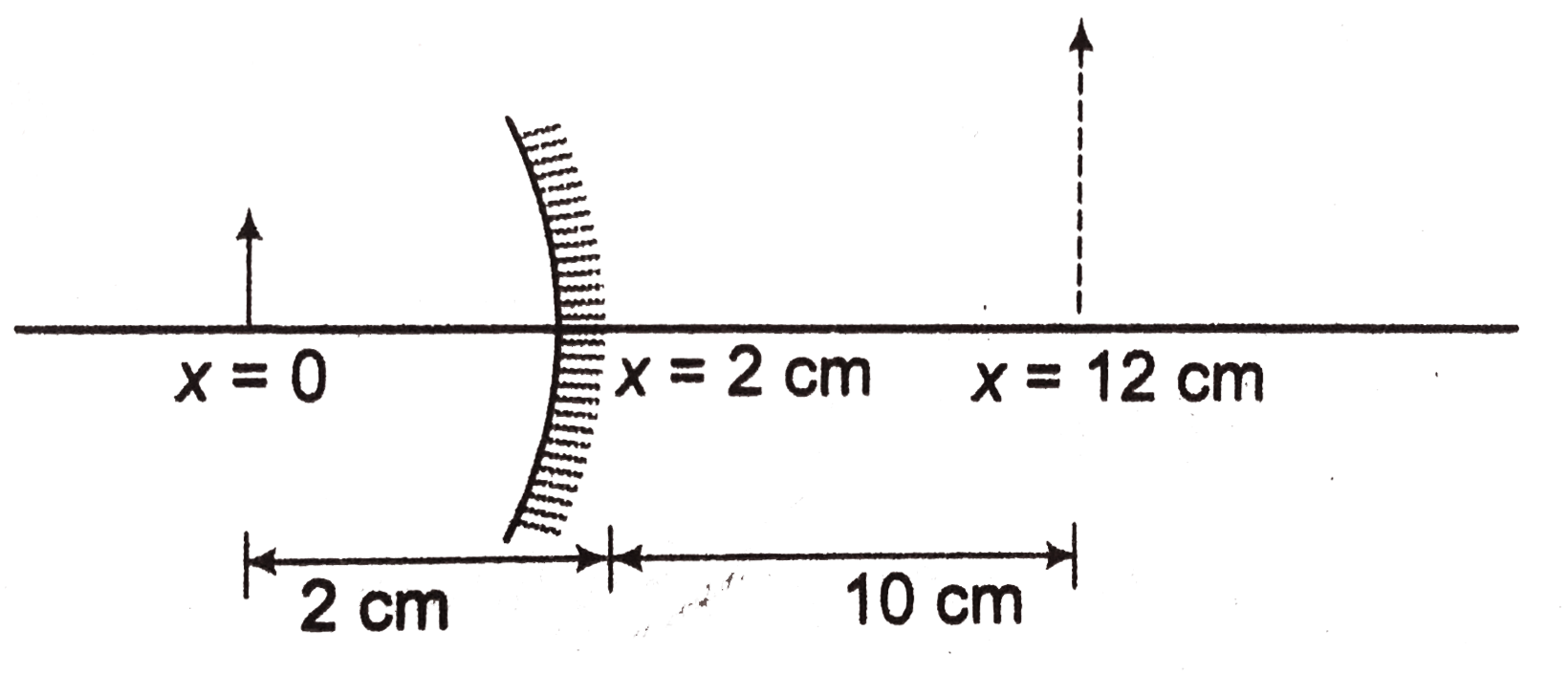Point A (0, 1 cm) and B (12 cm, 5 cm) are the coordinates of object and image x-axis is the principal axis of the mirror. The, this object image pair is
due to a convex mirror of focal length 2.5 cm
due to concave mirror having its pole at (2 cm, 0)
due to a concave mirror having its pole at (-2 cm, 0)
Data is insufficient
The correct Answer is:B

∴ V should be positve and 5 times |u|.
Topper's Solved these Questions
- BOOK - DC PANDEYCHAPTER - REFLECTION OF LIGHTEXERCISE - Level 2 More Than One Correct6videos
REFLECTION OF LIGHT
- BOOK - DC PANDEYCHAPTER - REFLECTION OF LIGHTEXERCISE - Level 2 Comprehensive Based4videos
REFLECTION OF LIGHT
- BOOK - DC PANDEYCHAPTER - REFLECTION OF LIGHTEXERCISE - Exercise Level 1 Subjective17videos
REFLECTION OF LIGHT
- BOOK - DC PANDEYCHAPTER - RAY OPTICSEXERCISE - Medical entrance gallary76videos
RAY OPTICS
- BOOK - DC PANDEYCHAPTER - REFRACTION OF LIGHTEXERCISE - Level 2 Subjective21videos
REFRACTION OF LIGHT
Similar Questions
A concave lens of focal length 20 cm is placed 15 cm in front of a concave mirror of radius of curvature 26 cm and further 10 cm away from the lens is placed an object. The principal axis of the lens and the mirror are coincident and the object is on the axis Find the position and nature of the image.
View SolutionA point object (A) is kept at a distance (L) from a convex mirror on its principal axis. A glass slab is inserted between the object and the mirror with its refracting surfaces perpendicular to the principal axis of the mirror. The thickness of the slab is 6 cm and its refractive index is 32. The image formed after refraction through the slab, reflection from the mirror followed by refraction through the slab is a virtual image at a distance of 10 cm from the pole of the mirror (on its principal axis). Consider paraxial rays only and calculate the distance (L) of the object from the mirror. Focal length of the mirror is f=20cm.
 View Solution
View Solution
Knowledge Check
- Question 1 - Select One or More
The image of an exend object placed perpendicular to the principal axis of a mirror, will be erect if
Athe object and the image are both realBthe object and the image are both virtualCthe object is real but the image is virtualDthe object is virtual but the image is real - Question 2 - Select One
In the figureshownm the image of a real object is formed at point I. AB is the principal axis of the mirror. The mirror must be
 Aconcave and placed towards right of IBconcave and placed towards left of ICconvex and placed towards right of IDConvex and placed twowards left of I
Aconcave and placed towards right of IBconcave and placed towards left of ICconvex and placed towards right of IDConvex and placed twowards left of I - Question 3 - Select One
In the figureshownm the image of a real object is formed at point I. AB is the principal axis of the mirror. The mirror must be
 AConcave & placed towards right IBConcave & placed towards Ieft of ICConvex and placed towards right of IDConvex & placed towards left of I.
AConcave & placed towards right IBConcave & placed towards Ieft of ICConvex and placed towards right of IDConvex & placed towards left of I.
A concave mirror forms a real image, on a screen of thrice the linear dimension of a real object placed on its principal axis. The mirror is moved by 10 cm along its principal axis and once again a sharp image of the object is obtained on the screen. This time the image is twice as large as the object. Find the focal length of the mirror.
View SolutionAn object of 10 cm is.placed at a distance of 20 cm from a lens of focal length 25 cm. The object is placed erect on the principal axis of the. lens yet a crooked image was formed. Explain why.
View SolutionAn object is placed on principal axis of concave mirror at distance of 1.5 f Image will be at
View SolutionA slab of glass, of thickness 6 cm and refractive index 1.5, is placed in front of a concave mirror, the faces of the slab being perpendicular to the principal axis of the mirror. If the radius of curvature of the mirror is 40 cm and the reflected image coincides with the object, then the distance of the object from the mirror is
View SolutionA slab of glass, of thickness 6 cm and refractive index 1.5, is placed in front of a concave mirror, the faces of the slab being perpendicular to the principal axis of the mirror. If the radius of curvature of the mirror is 40 cm and the reflected image coincides with the object, then the distance of the object from the mirror is
View Solution

